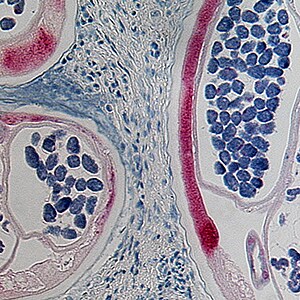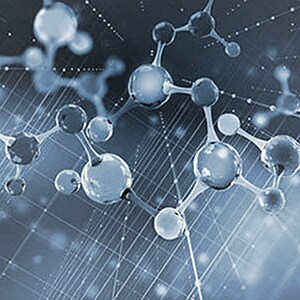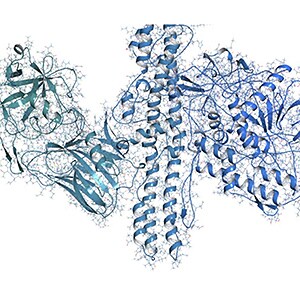
»[E.] Merck [Darmstadt, Germany] has entered the genome research era. Training has already begun for the approximately 40 employees in preclinical pharmaceutical research. Participants will deepen their expertise in molecular biology and its methods and receive an introduction to special highly advanced software applications.«
Company's employee newspaper, 1996
The end of the 20th century is marked by the new opportunities that genome research opens up for drug discovery and precision medicine. Keen to utilize those opportunities, the company engages in a large-scale partnership with the firm Human Genome Sciences of the United States and various global pharmaceutical companies as early as 1996 to gain access to the expressed portion of the human genome via expressed sequence tags, or short DNA sections of active genes. More than five years before the full sequencing of the human genome, expressed sequence tags give detailed insights into disease processes at the level of gene expression.
The aim is to utilize the possibilities afforded by the then-novel high-throughput screening, or the investigation of large libraries of chemical compounds for their affinity to disease-relevant proteins (targets) as a first step in drug discovery. This method in turn is the result of another technical revolution: robotics. Like most pharmaceutical companies in the pre-1990s period, the company studies a new target once every couple of years. To make rational use of the costly new systems, it is suddenly now important to have around a dozen a year. Genome research promises to be the key to effective target-identification.
A gold-rush mentality takes hold in the pharmaceutical industry as companies seek to »stake their claims« by patenting as many disease-relevant genes as fast as possible. In the year 2000, at the height of these activities, Merck KGaA, Darmstadt, Germany, files for patents on more than 60 genes in an initiative dubbed »SixPaG« (Sixty Patents from Genomics). But while the company expends vast resources in areas including genomics and bioinformatics education, identifying numerous potentially useful genes along the way, patent offices all over the world keep raising the bar for patents of this kind. Not a single application results in a patent being granted.
All that work and expense for nothing, one might think. Not so: The collaborative effort and all the associated measures such as building up a powerful proprietary bioinformatics platform transform the company to the core, elevating molecular biology from a niche existence to a permanent role in every aspect of pharmaceutical research at the highest level. The company is now finally able to realize an even older vision from 1987 that was bold in its day: antibody therapy. Dynamic growth in the area of protein-based active ingredients, also referred to as biologics, isunabated and creates excellent prospects.
In 2020, we are at the threshold of another technological revolution: artificial intelligence, a hot topic with implications that are both awesome and potentially alarming. Advances in computing power and algorithms are making things possible that surpass individual human skills.
Artificial intelligence approaches have applications in pharmaceutical research, for example in the analysis of histology samples. Predictive modeling of active ingredient properties is a major area of activity, with deep learning using large neural networks playing a very significant role.
Deep learning can even be used to generate radically new molecules while screening them for selected active ingredient properties. As of 2020, developments are in their infancy, but the research world is well positioned to face the future.









